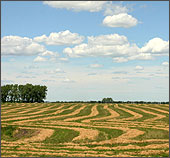Tools Menu
- November 13, 2006
- Quick Links
- Contact Information
Main Menu
- Skip to Page Content
- About Byron
- Constituent Services
- Issues & Legislation
- North Dakota Initiatives
- Newsroom
- For Students
- Contact Info
North Dakota Initiatives

North Dakota Initiatives
Red River Valley Research Corridor
In early 2002, U.S. Senator Byron Dorgan convened a meeting with the presidents of North Dakota’s public universities and colleges. He proposed a bold new program to bring millions of federal research dollars to North Dakota. His purpose: to use science and technology as an engine to help bolster the region’s economy; to build and attract high-tech businesses; to generate new economic opportunities; and to create good paying jobs for the region. The state’s two major research institutions anchor the Corridor: North Dakota State University in Fargo and the University of North Dakota in Grand Forks. The impact of the Red River Valley Research Corridor is not limited to the eastern part of the state. By design, the Corridor reaches out to universities and businesses in every corner of North Dakota. With the focus on high-tech, the Corridor is already stimulating a cycle of federal research projects, high-paying jobs and economic development throughout the state.
Senator Dorgan’s Energy Plan for North Dakota
North Dakota is poised to play a vital role in reducing our dependence on foreign sources of energy. Our diversified energy portfolio puts our state in the unique position to help us achieve our goal by contributing traditional fossil fuels, as well as newly competitive renewable fuels.
National Center for Hydrogen Technology
In 2004, Senator Dorgan included a provision in an appropriations bill to designate the Energy and Environmental Research Center (EERC) as the National Center for Hydrogen Technology (NCHT). In the same bill, he secured $3 million for initial cornerstone funding for the NCHT, and an additional $2.5 million the following year.
National Energy Technology Training and Education Facility
Senator Dorgan has earmarked $1.2 million since FY03 to help develop Bismarck State College’s nationally recognized energy training program. In addition, Dorgan is working on federal funding to help construct a $14.5 million National Energy Technology Training and Education Facility on the campus of Bismarck State College. This world-class facility will house a Workforce Training Center and Higher Education Center creating a learning atmosphere that combines energy education with environmental education while advancing the use of coal combustion products. Working in partnership with industry to deal with the approaching shortage of multi-skilled technicians, Bismarck State College has put in place the education and training necessary to prepare a workforce for reliable and safe generation transmission and distribution of electric power. These energy programs have become nationally recognized with graduates working in 47 states.
Devils Lake - Upper Basin Water Utilization Irrigation Test Project
Senator Dorgan earmarked $900,000 in federal funding in a demonstration project to test the feasibility of taking excess water off Devils Lake and aid in the growing of certain specialty and standard crops in the Devils Lake region. Ten irrigation sites covering 1,100 acres have been set up in five counties. If successful, the test project could be expanded to a full scale project involving an additional 4,000 acres in 2008. An NDSU study shows a difference of $481 income per acre between traditional cropping and irrigation. This effort has the potential to be a win-win project by reducing water levels in the lake and improving the farm economy of the region.
Nanoscience Technology Training Center- NDSCS
The Center for Nanoscience Technology Training at the North Dakota State College of Science in Wahpeton is a natural extension of the Red River Valley Research Corridor. The Center will provide students and workers in the region with the skills and training to succeed in nanotechnology and other new industries created through the Research Corridor initiative. The Center plans to begin workforce training activities this fall and will begin accepting enrollments into the AAS degree in the Fall of 2006.